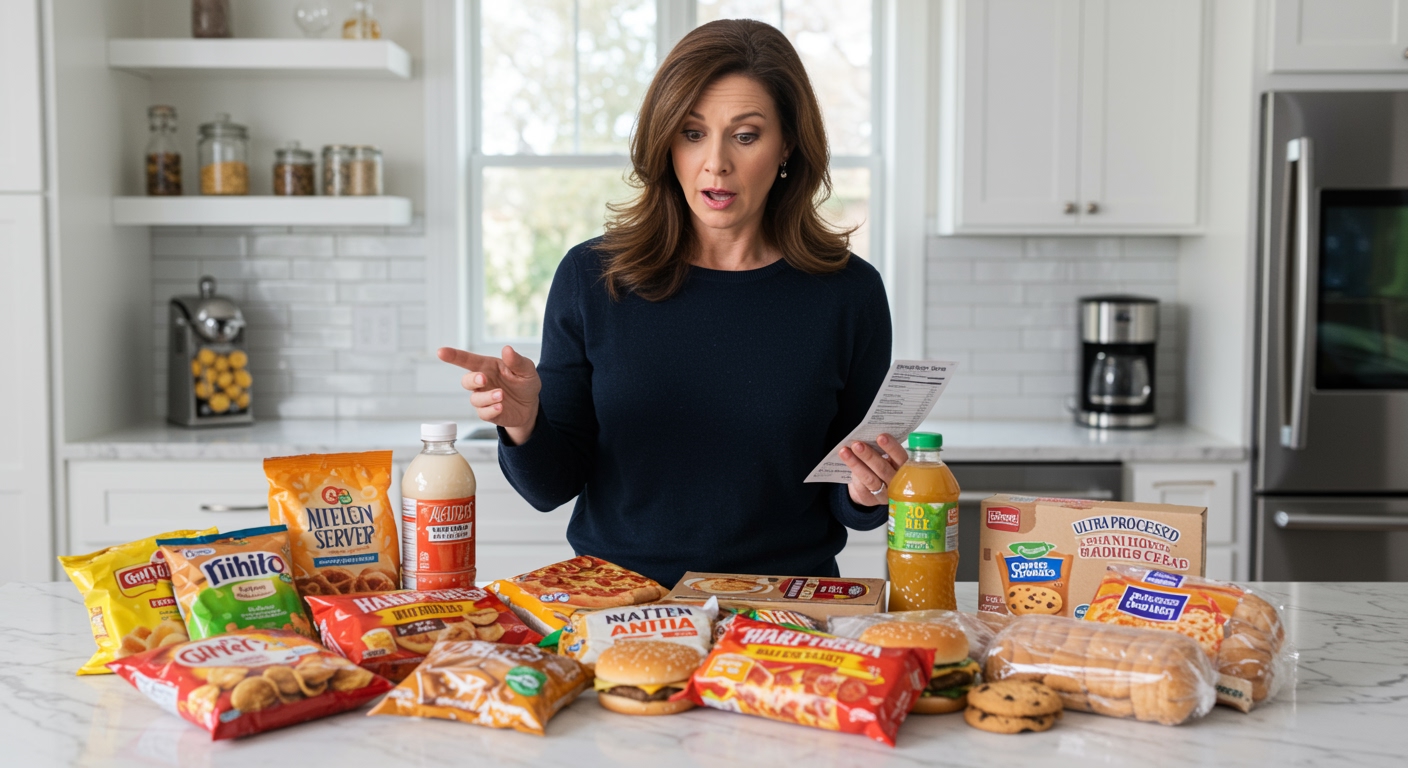✪ Key Highlight: CDC data shows 55% of American calories still come from ultra-processed foods, with children consuming 62% despite recent declines.
Introduction
Your grocery cart tells a story about your health that you might not want to hear.
New research from the Centers for Disease Control and Prevention reveals that ultra-processed foods still make up more than half of all calories consumed by Americans, despite small improvements over the past decade.
Hi, I’m Abdur, your nutrition coach and today I’m going to analyze this alarming CDC report about ultra-processed food consumption in America and what it means for your family’s health.
What Does The New CDC Data Actually Show?
The CDC’s latest findings paint a concerning picture of American eating habits that affects every age group differently.
About 55 percent of all calories consumed by Americans over age one come from ultra-processed foods, with adults consuming slightly less at 53 percent.
Children and teenagers under 18 show the most alarming numbers, getting nearly 62 percent of their daily calories from these industrially manufactured products.
The highest consumption occurs in children aged 6 to 11, who get almost 65 percent of their calories from ultra-processed foods.
Young children actually consume fewer ultra-processed calories than older kids, while adults over 60 tend to eat fewer than younger adults.
These numbers represent a small but measurable decline from a decade ago, when adults got 56 percent of calories from ultra-processed foods and children consumed about 66 percent.
✪ Fact: Children aged 6-11 consume the highest percentage of ultra-processed food calories at nearly 65 percent of their daily intake.
Which Foods Are Driving These Numbers?
The study identifies specific food categories that contribute most heavily to ultra-processed food consumption across all age groups.
Sandwiches and burgers top the list as the single largest contributor to ultra-processed food intake for both adults and children.
Baked goods like cookies, cakes, and pastries represent another major source of these calories in the American diet.
Pizza consumption adds significantly to the ultra-processed food totals, especially among younger demographics.
Sweetened beverages including sodas, sports drinks, and flavored waters contribute substantial calories from artificial additives and high fructose corn syrup.
Savory snacks like chips, crackers, and processed cheese products round out the top contributors to ultra-processed food consumption.
These foods are ubiquitous in American stores and restaurants, making them difficult for many families to avoid completely.
✪ Pro Tip: Always check ingredient lists and choose foods with five or fewer recognizable ingredients to reduce ultra-processed food intake.
How Does Income Affect Ultra-Processed Food Consumption?
Economic factors play a significant role in determining how much ultra-processed food families consume on a daily basis.
Adults with lower incomes consume more calories from ultra-processed foods compared to those with higher incomes, according to the CDC data.
This pattern suggests that affordability and accessibility are major factors driving food choices across different socioeconomic groups.
Ultra-processed foods often cost less per calorie than fresh, whole foods, making them attractive options for families on tight budgets.
These products also have longer shelf lives and require minimal preparation time, appealing to busy families with limited resources.
The convenience factor becomes especially important for working parents who lack time for meal planning and preparation.
However, this short-term convenience comes with long-term health costs that disproportionately affect lower-income communities.
✪ Note: Lower-income families consume more ultra-processed foods due to affordability and convenience factors rather than personal preference.
What Are Ultra-Processed Foods And Why Should You Care?
Understanding the NOVA classification system helps you identify which foods fall into the ultra-processed category.
Ultra-processed foods are industrially manufactured products that contain artificial additives like dyes, flavorings, and preservatives not found in home kitchens.
These products typically contain high amounts of added sugars, unhealthy fats, and sodium while being low in dietary fiber and whole food ingredients.
The manufacturing process often strips away natural nutrients and replaces them with synthetic vitamins and minerals.
Many health experts warn that excessive consumption of ultra-processed foods links to higher risks of obesity, heart disease, type 2 diabetes, and premature death.
These foods are designed to be hyperpalatable, meaning they trigger reward pathways in your brain that can lead to overconsumption.
The combination of high calories, low satiety, and addictive qualities makes it easy to consume more calories than your body needs for optimal health.
✪ Fact: Ultra-processed foods are designed to be hyperpalatable, triggering brain reward pathways that can lead to overconsumption and health problems.
Why Are The Numbers Finally Starting To Drop?
The small but measurable decline in ultra-processed food consumption offers hope for improving American dietary habits.
CDC co-author Anne Williams noted that while the numbers remain high, the downward trend represents real progress in public health efforts.
Nutrition expert Andrea Deierlein from New York University suggests that growing public awareness about nutrition might be driving this positive change.
More people are actively trying to decrease their intake of ultra-processed foods, at least in some population groups.
Education campaigns and better nutritional information may be helping some families make healthier choices when shopping and dining out.
However, researchers cannot determine from the data whether people are eating less overall or simply choosing fewer ultra-processed options specifically.
The decline could also reflect changes in food availability, marketing practices, or economic factors rather than conscious health decisions alone.
✪ Pro Tip: Growing nutrition awareness and education campaigns are helping some Americans reduce their ultra-processed food consumption gradually.
The Bottom Line
Despite small improvements, ultra-processed foods still dominate the American diet, especially among children and lower-income families who face the greatest barriers to accessing healthier options.
Real change requires more than individual willpower – it demands better food policies, clearer labeling, and affordable healthy alternatives for everyone.
I want to hear from you in the comments below – what challenges do you face when trying to reduce ultra-processed foods in your family’s diet, and what strategies have worked best for you?
References
At NutritionCrown, we use quality and credible sources to ensure our content is accurate and trustworthy. Below are the sources referenced in creating this article:
- Civil Eats: CDC Report Shows Ultraprocessed Foods Remain a Staple of the American Diet
- CDC: Ultra-processed Food Consumption Among U.S. Adults and Children
- National Public Health Information Coalition: Ultra-processed Food Consumption is Down a Bit
- Food Bible: New Report Reveals How Much UPFs Americans Are Consuming





